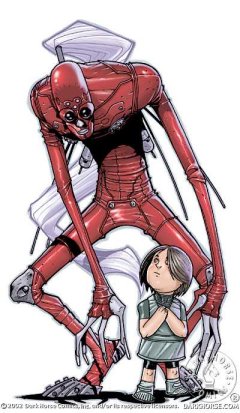| Lone
Wolf 2100: Shadows On Saplings
A while
back I reviewed Lone Wolf
and Cub from Kazuo Koike and Goseki Kojima, one of
the few manga that I have ever liked and the only manga I've
ever shelled out the cash to buy (and am still buying -- damn
26 volumes).
We've
recently seen a glut of what the American comics industry
is calling "manga-influenced comics," with the already
doomed (at least I'm predicting it is) Marvel Tsunami line,
as well as the Tokyo Pop! offerings and the lauded Shonen
Jump and Raijin Comics.
To tell
you the truth, I'm very confused on what exactly companies
like Marvel are thinking when they launch these kinds of lines:
while Japanese comics work well in Japan (and many work here
as well, I know), the entire business structure of Japanese
comics is different from America, from the amount of genres
that the Japanese comics have, right down to the paper grade
they are printed on.
My point
is that American comics are having a collective identity crisis.
Too many books are trying and failing to emulate manga in
hopes of drawing in manga fans. One book (in fact the only
book that I've yet found) manages to straddle the manga/American
comics fence and actually makes for a nicely done book. That
book is Lone Wolf 2100: Shadows On Saplings, written
by Mike Kennedy and drawn by Francisco Ruiz Velasco.
Lone
Wolf 2100 isn't a retelling of the original story from
Lone Wolf and Cub, nor is it an inevitably lame sequel.
It is instead, as quoted from the book's foreword, "a
respectful re-imagining, that borrows liberally from the original's
core concept, but follows it's own path..."
The previous
quote is very true in that Lone Wolf 2100 takes the
best things from both Japanese comics like its predecessor
and American comics: those being Japanese flair for exceptional
art (which LWaC was known for) and American storytelling (far
better at carrying a consistent, yet non-repetitive plot than
Japanese, bar none).
Kennedy
tells the story of Itto, an organic android, called EmCons
in this future, who has been entrusted with the life of his
former master's child, Daisy Ogami. They're on the run from
the company that built Itto, as well as trying to survive
in a future infested with a virus called the Spore.
The company
believes that Itto killed Dr. Ogami and stole his daughter
for a group of rebel EmCons, claiming Daisy is the carrier
for an even worse virus than the Spore and that Itto is attempting
to hand her over to end human life on the planet. Itto must
protect Daisy from the paramilitary forces hunting them, as
well as the diseased wasteland the world has become, but its
true purpose in protecting Daisy has yet to be revealed.
While
it does borrow a concept from its predecessor, LW2100
stands on its own. You need not have read LWaC to understand
it. The great thing about Kennedy's writing is that he writes
a great action book, but manages to slip in all the relevant
plot and background for the characters without losing momentum.
Itto is first introduced without any background information,
and Kennedy expertly slides a flashback sequence or essential
exposition into exactly the right places to flesh out the
character's background and explain the other players in the
book. Itto's main pursuer, Mr. Prescott is a fairly unexplored
character, but Kennedy still gives us tidbits of history for
him as the book progresses.
Kennedy
does also manage to honor Koike's original history-laden story
with the writing on this book, as he creates history for a
future that hasn't happened yet, including pseudo-scholarly
quotes from an unexplained doctor throughout the book.
The art
on this book is so damn beautiful I am almost at a loss for
words. I know that I've seen Velasco's artwork before, but
I can't place where. In a word, it is stunning the way Velasco
draws the characters, structures, and technology of LW2100.
It's influenced by manga and the original material, but only
faintly and I would venture to say that Velasco has probably
worked in Europe because his style screams it (and if those
Europeans know anything, it's art…… and maybe chocolate
making).
He has
a masterful hand at the action; every time Itto is tearing
into a group of baddies (and I'm being literal when I say
"tearing into"), the movements are kinetic and the
energy flows from panel to panel, much in the same way Kojima's
artwork did in LWaC.
And the
character designs this man comes up with are so much fun;
he actually remembers that the book is set in Japan and the
surrounding islands, and incorporates that into his designs.
People are wearing ratty old kimonos and wearing knots in
their hair, and not a hip-hugger is to be found.
I like
this book and was glad to see Dark Horse actually put out
the comic in trade form. I was less happy at the price of
$12.95 for what equates to 4 issues of comics. It's also printed
in smaller format, which I'm mixed about because I thought
the reason for a smaller format was to lower prices, but I
could have gotten full sized issues for around the same price.
Oh well. I recommend this book for anyone who likes the original
Lone Wolf, as well as anyone who likes sci-fi action and post-apocalyptic
futures because this book has it all.
Until
next time when I write about the tastefully well done homage
to the spectacular 1970s comic, Brother Power the Geek (Even
I'm laughing and cringing at that one).
Lone Wolf 2100: Shadows on Saplings
|







